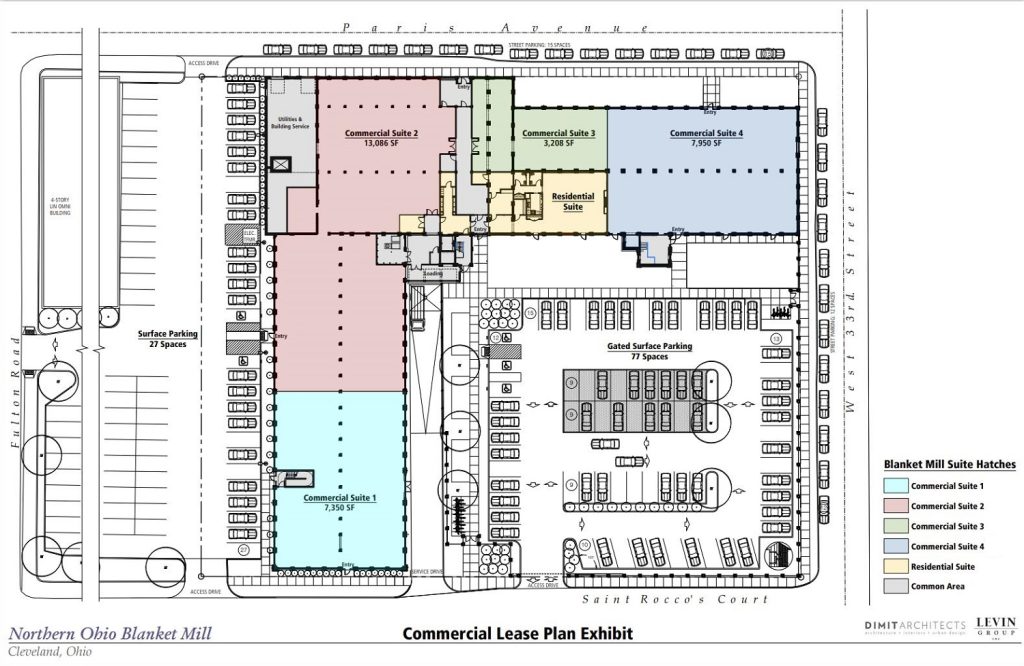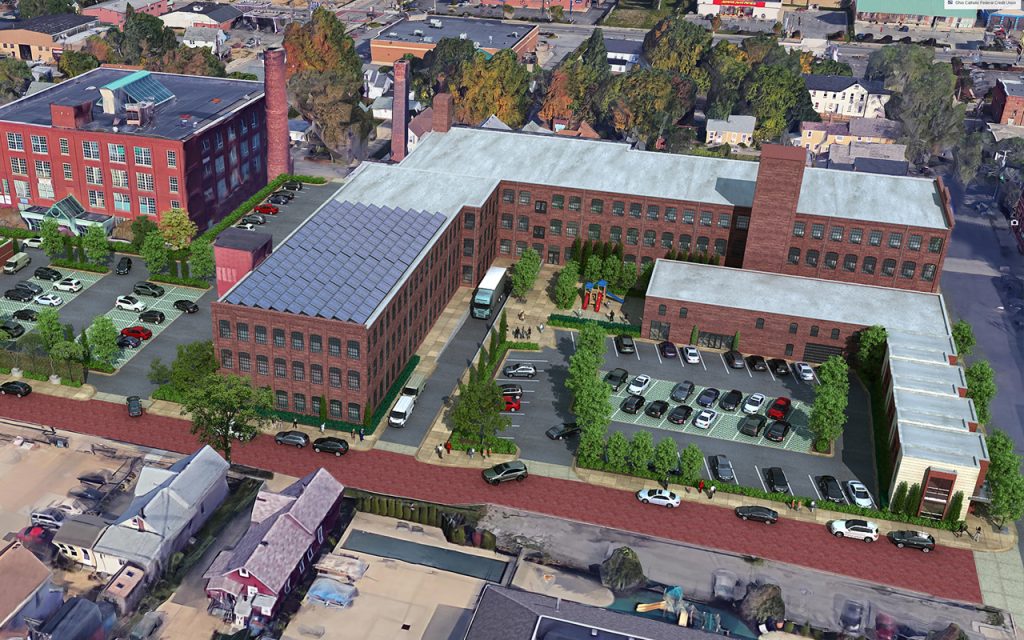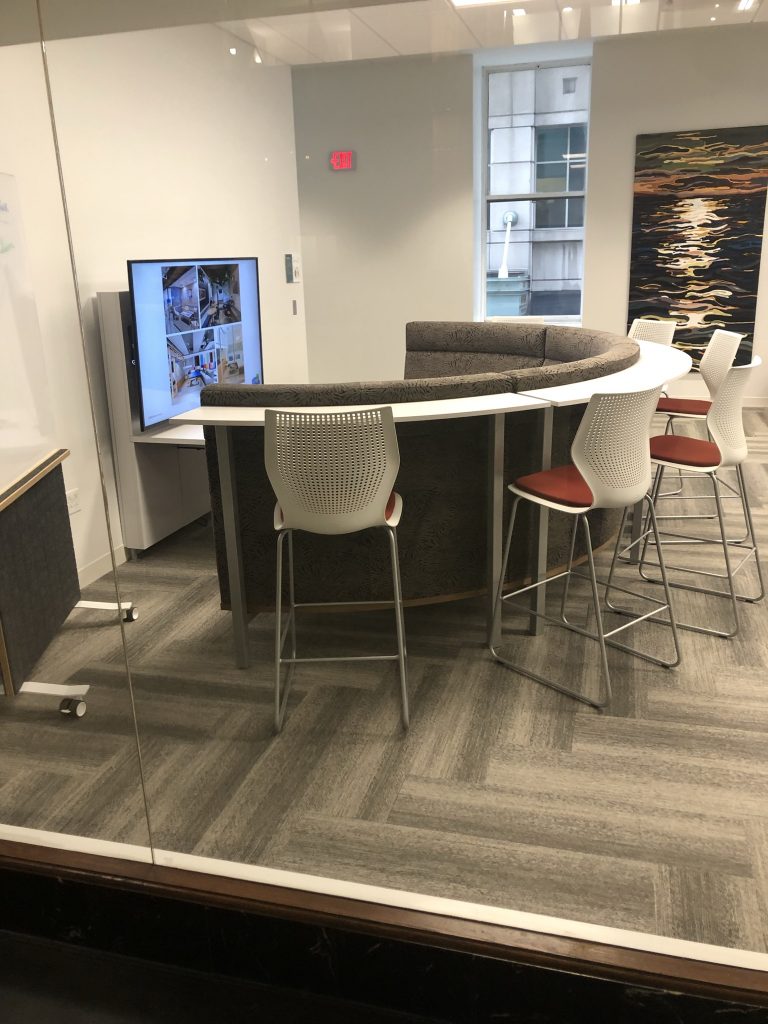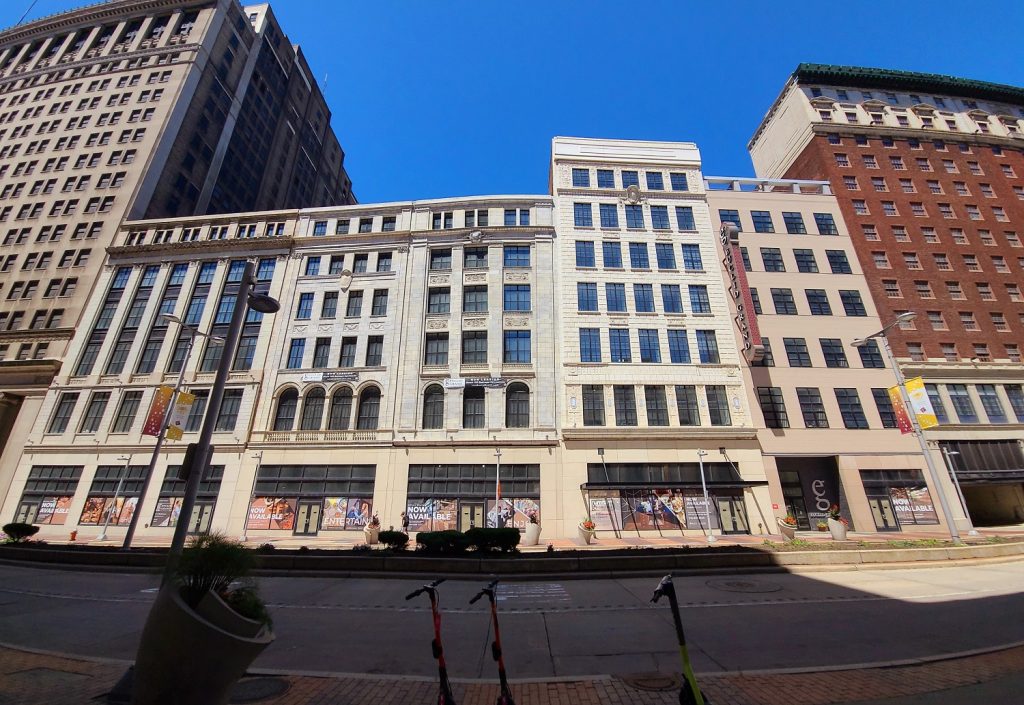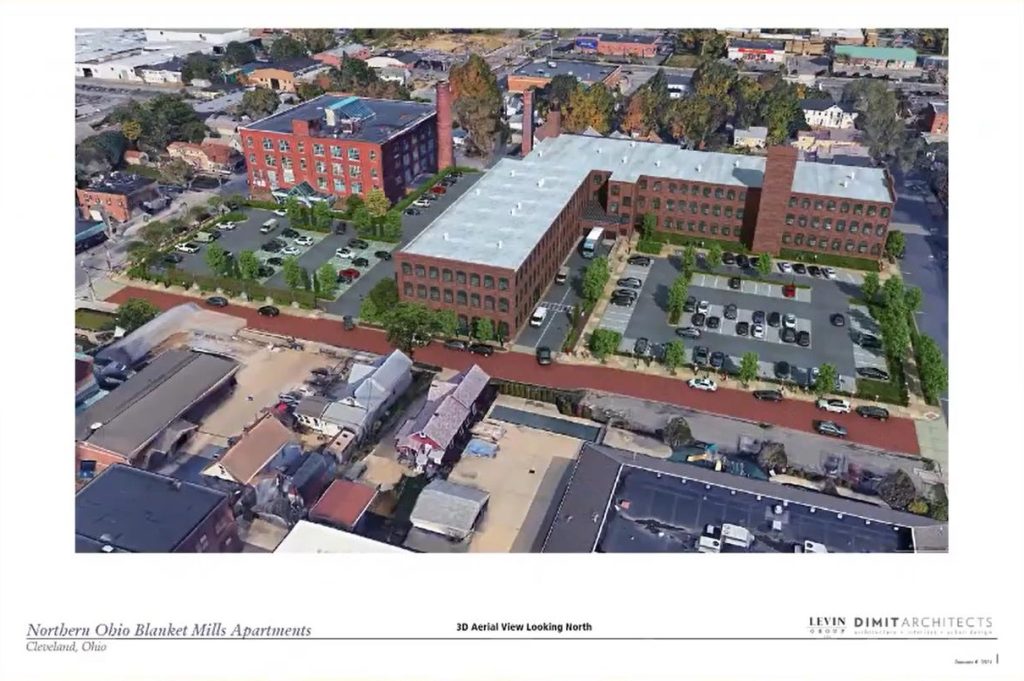
In this northward-looking view, the Northern Ohio Blanket Mills is fully redeveloped. However, some last-minute refinements are being provided to the site and new commercial tenants are being accommodated. The brick street across the image is St. Rocco’s Court with Fulton Road and the Lin Omni Square on the left. West 33rd Street is to the extreme right (Dimit). CLICK IMAGES TO ENLARGE THEM.
Two commercial tenants sign on to project
ARTICLE UPDATED JUNE 13, 2024
For more than 15 years, the landmark Northern Ohio Blanket Mills, 3160 W. 33rd St., sat empty and decaying. But this summer, following a $30 million renovation, residential and commercial tenants are moving into the 19th-century factory in Cleveland’s Clark-Fulton neighborhood that was once the country’s largest manufacturer of woolen horse blankets and carriage robes.
The 112,000-square-foot, mixed-use project has evolved over time due to changing market conditions and financial constraints. At one point last fall, with the project nearing completion, high costs of construction materials threatened its progress. But the city came through with a $1 million grant from a municipal housing program funded by the American Rescue Plan Act, dubbed the Recovery Act so work could be finished.
Levin Group of Cleveland and the Metro West Community Development Organization are co-developers of the project. The former textile plant features 60 apartments for people having incomes that are 60 percent of the area median income or less.
Northern Ohio Blanket Mills was built from 1889-1895 and is listed on the National Register of Historic Places. Applications for residences in the building are being accepted through the Cuyahoga Metropolitan Housing Authority.
“This project is an exceptional addition to our neighborhood, and I am thrilled that many of our families will be able to stay in the neighborhood because of these affordable units,” said Ward 14 Councilwoman Jasmin Santana in a written statement.
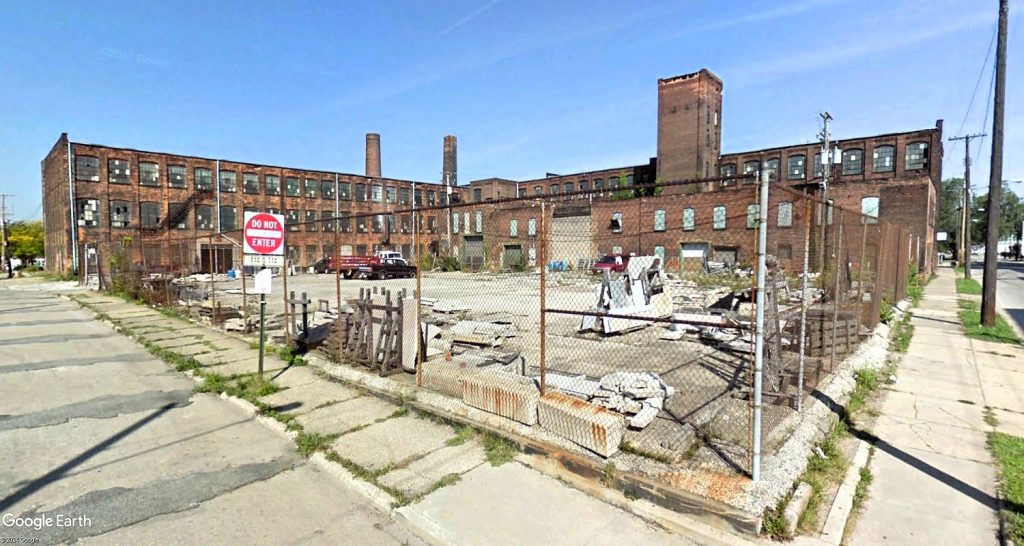
In 2009, the Northern Ohio Blanket Mills property had just been vacated the year before. But you wouldn’t know it by looking at it from the courtyard/parking side. The property had fallen into disrepair and would decay further over the next 15 years of vacancy. Most of the landmark building was saved (Google).
“We are pleased to work closely with Councilwoman Santana and the community to return this historic building into a productive asset for the Clark-Fulton neighborhood,” Mort Levin, president of Levin Group, Inc., in a recent press release.
The property has been the subject of redevelopment plans since at least 2009. project Because of its co-sponsorship, Metro West will also be one of the building’s ground-floor commercial tenants even though it is moving from just a few hundred feet away at its current home at the Lin Omni Square which was built as part of the blanket mills.
It will be leasing 3,208 square feet and investing $336,840 to build out the space for its new offices, according to plans filed last week with the city’s Building Department. Its offices will look out onto Paris Avenue which has 15 spaces of on-street parking. Another 12 spaces of on-street parking are on West 33rd. There are 104 spaces of off-street parking divided among two lots.
“We are still in an active lease with Lin Omni and plan on honoring that,” said Metro West Executive Emily Lee. She didn’t clarify how long the CDC’s lease with Lin Omni is.
An even larger incoming tenant submitted plans to locate in the Northern Ohio Blanket Mills development. Little Steps Bilingual Enrichment Center will lease 7,950 square feet at the L-shaped building’s east end. It will invest about $914,250 to build out its space, according to a permit application filed with the city last week.
Little Steps is currently located at 4732 Lorain Ave. but is pulling up stakes to make way for a redevelopment by Forest City Shuffleboard owner and developer Jim Miketo. A new apartment building over ground-floor retail will be built next door to the historic building in which Little Steps currently is located. In its place on Lorain will be a new but as-yet unidentified restaurant topped by amenity spaces for the adjacent apartments.
“I do not have anything to respond to due to the fact that we have not signed a contract and decisions still need to be made,” said Ramonita Vargas, chief executive director of the Spanish American Committee which operates Little Steps among its programs.
At the Northern Ohio Blanket Mills, that leaves about 20,000 square feet of ground-floor commercial space as available for two more commercial tenants. When the current project was getting started in 2016 and tax credits were being sought by Levin Group from the Ohio Housing Finance Agency, a spokesperson for the developer said the commercial space would be “ideal for a neighborhood health clinic.”
There was actually more commercial space originally planned in the development — and residential spaces, too. Envisioned was about 40,000 square feet of ground-floor commercial space that included a single-story, attached building in the courtyard of the complex.
That structure was too far gone to be affordably renovated so it was demolished. An outdoor play area for Little Steps will be provided in its place. There will also be a shaded play area for Little Steps on the north side of the building.
Another component was left to a future phase whenever construction prices and interest rates fall. Four townhomes are proposed to be built along West 33rd, requiring the elimination of 13 parking spaces in the lot. If and when they are built, the townhouses would have indoor garage parking accessed from the parking lot. That will provide a residential frontage along West 33rd.
The upper floors of the three-story building will have 60 low-income one-, two- and three-bedroom apartments with high ceilings and large windows. Levin Group had previously considered redeveloping the building with 73 units of affordable housing for seniors.
“This is a project I’ve worked on since I was first elected to Council,” Santana said. “The financing of the renovations was very complicated. But I’m so excited and thankful that my colleagues on Council agreed that this was a good use of the city’s revenue recovery funding.”
In addition to the grant from the city and tax credits from the state, construction financing came from Citizens Bank and a Cleveland Development Advisors Community Development Financial Institution loan. PNC Bank acquired the Low Income Housing Tax Credits from the state to provide equity financing for the project, according to a press release from Levin.
Prior to its redevelopment, Custom Metal Fabricators Inc. was the last user of the property, from the 1980s until 2008. Another user was a piano restoration business that was located in the one-story building that was demolished by Levin.
In 1880, Herman Beckman Sr. founded the Northern Ohio Blanket Mill on West 33rd, then-called Pleasant Street. The company’s original factory was destroyed by a fire in February 1888. A new factory opened in 1889 but was shut down by the nationwide Panic of 1893. The New York Times reported on Dec. 15, 1893 that the Northern Ohio Blanket Mill “will resume operations on Jan. 2, 1894 in all its departments, giving employment to 250 men.”
Despite the growth in the number of automobiles, the horse blanket-maker expanded in 1912 toward Fulton by constructing the mills’ largest building, now the Lin Omni Square. But as automobiles began to enclose their passenger compartments and have heaters, the blanket mills went out of business in 1928, said Steve Mcquillin who did historic preservation consulting work for a prior owner of the site.
After the blanket biz faded, the factory was used next by an industrial laundry company in the 1930s. Surprisingly it remained vacant during World War Two. A furniture maker called it home in the 1950s. American Greetings Co. used it as a warehouse in the 1960s and it was occupied by a plumbing supply company in the 1970s.
END

